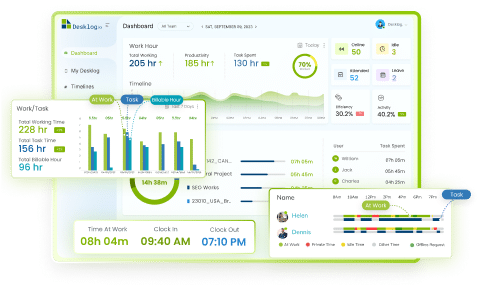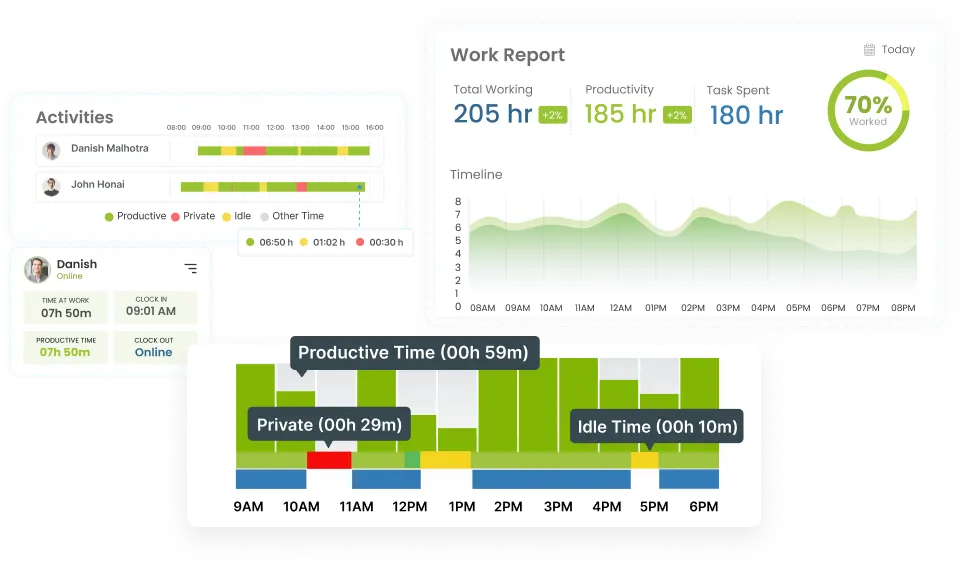
Best Practices for Implementing a Clock-In Clock-Out System
Considering today’s work environment, efficiently managing employee hours is paramount. Know why? It helps to optimise productivity, ensure fair compensation, and comply with labour regulations, ultimately contributing to a healthy and sustainable workplace. Having said that, an efficient time tracking software is the cornerstone of this endeavour.
A sophisticated clock-in clock-out system can enhance accuracy, streamline processes, & elevate overall workforce management. Sounds pretty cool, right? Yes, for sure. This blog will guide you through the best practices for implementing a clock-in clock-out system into your organisational framework.
What is a clock-in clock-out system?
A clock-in clock-out system is a time tracking method used by organizations to monitor and record employees’ work hours, as defined by Forbes. It allows employees to log their start and end times for each workday, providing a clear record of their attendance.

Did you know
According to a survey conducted by the American Payroll Association, automated employee clock-in clock-out systems can reduce payroll processing time by up to 80%.
The best clock in clock out apps streamline this process, offering user-friendly interfaces and features for efficient time management. These applications not only track hours but also contribute to improving the efficiency rates of an employee by providing insights into work patterns and productivity. By automating the time tracking process, organizations can optimize resource allocation and make data-driven decisions to improve workflow efficiency.
Practices for Implementing a Clock-In Clock-Out System in Your Business
A perfect clock-in clock-out system for your business ensures precision in tracking work hours while promoting employee engagement. Here are 10 practices to consider when implementing a clock-in clock-out system in your company:
- Establish Clear Guidelines
- Provide Incentives
- Simplify the Process with Software
- Highlight the Benefits
- Consider Disciplinary Measures
- Transparent Time Tracking Policies
- Regular Monitoring & Auditing
- Adaptability to Employee Needs
- Integration with HR Systems
- Continuous Feedback & Improvement
1. Establish Clear Guidelines:
Effectively communicate the purpose of the clock-in clock-out system and provide comprehensive training, ultimately boosting employee productivity. Ensure employees understand about optimizing workflow and adhering to efficient time management practices.
2. Provide Incentives
Encourage adherence to the clocking system by offering rewards. Recognize and reward employees who consistently follow the clock-in and clock-out procedures. This helps create a positive atmosphere around timekeeping.
3. Simplify the Process with Software
Use user-friendly time clocking software to streamline the process for your employees. Simple software makes it easy for them to clock in and out, reducing the likelihood of forgetfulness. This not only improves accuracy but also enhances overall work efficiency.
4. Highlight the Benefits:
Design the system to be adaptable to various employee needs, fostering flexibility in work arrangements. It is crucial to understand how to manage time, and this may be achieved by providing training to staff members so they can optimize their schedules.
5. Consider Disciplinary Measures:
If, despite efforts, some employees consistently struggle with clocking in and out, consider taking measured disciplinary action. Start with a gentle verbal warning, progressing to more serious actions if the issue persists.
6. Transparent Time Tracking Policies:
Establish clear policies on time tracking. Having said that, this will be beneficial for the employees to understand the importance of accurate time tracking and the consequences associated with engaging in additional employment during working hours
7. Regular Monitoring & Auditing:
Implement regular monitoring and auditing of time records to identify and address discrepancies promptly, fostering a healthy work environment. This proactive approach ensures that employees are not overburdened or pressured to engage in unsustainable work practices.
8. Adaptability to Employee Needs:
Design the system to be adaptable to various employee needs. It is crucial to understand how to manage time, and this may be achieved by providing training to staff members so they can optimize their schedules and make effective use of the system.
9. Integration with HR Systems:
Ensure seamless integration with other HR systems optimizes administrative processes and reduces errors. This cohesive integration streamlines workflows, leveraging tools for efficiency to enhance overall efficiency in time tracking and management.
10. Continuous Feedback & Improvement:
Foster a culture of continuous improvement by regularly seeking and incorporating employee feedback for system enhancement. Purchasing an app for employee productivity offers several advantages. Wondering how? Well, it can simplify processes & enhance accountability.
Why do you need a clock-in clock-out system?

Maximize Employee Efficiency:
A clock-in clock-out system is crucial to maximize employee efficiency by providing a transparent view of work hours. It ensures that each minute is accounted for, fostering a culture of productivity and time-consciousness.
Time Tracking Software vs Traditional Timesheet:
Unlike traditional timesheets prone to errors and delays, time tracking software offers real-time tracking, reducing inaccuracies. Automation eliminates manual data entry, streamlining the process and offering a more reliable means of recording and managing work hours.

Time Tracking Software for Entrepreneurs:
Entrepreneurs benefit from a clock-in clock-out system as it offers a centralized platform to monitor and manage team activities. Real-time insights into project timelines and employee contributions empower entrepreneurs to make informed decisions for business growth.

Time Tracking in Employee Evaluation:
Implementing a clock-in clock-out system aids in fair and efficient appraisal of employee performance. Managers can assess performance based on actual hours worked, project completion, and overall productivity, contributing to a more objective and equitable appraisal process.

Future of Employee Productivity:
As technology advances, time tracking software is at the forefront of shaping the next generation of employee productivity. Integrating AI and analytics, these systems not only track time but also provide valuable insights, enabling businesses to adapt and enhance productivity strategies for sustained success.

Enhanced Project Management:
A clock-in clock-out system facilitates efficient project management by offering a clear timeline of tasks and work hours. This transparency aids in resource allocation, project planning, and meeting deadlines, ultimately contributing to the success of the project and the organization as a whole.

Did you know
A study by the Workforce Institute revealed that businesses utilizing clock-in clock-out systems experience a notable 50% decrease in time theft.
Desklog : Perfect Clock in clock out system for your business
A perfect clock-in clock-out system for your business ensures precision in tracking work hours while promoting employee engagement. Here are a few practices to consider when implementing a clock-in clock-out system in your company:
 Automated Time Tracking
Automated Time Tracking
Whether you log in from the office or from home, you can keep track of your entire work time with the automated time tracking tool. This facilitates the recording of arrival, login, log-out, left, idle, offline, productive, and total hours worked in a given day, week, or month.
 Automated Timesheet
Automated Timesheet
A timesheet is a record that shows how much time an individual spends on a specific job or series of tasks over a given amount of time. It makes time spent on tasks and projects recordable. Organizations can alter task performance to cut down on the amount of time needed to finish jobs with the use of Desklog automated timesheet.
 Web Timer
Web Timer
This makes it possible for teams to measure time without having to download any apps, which makes it a flexible, practical, and affordable method. By enabling start, stop, and break functions as well, users may manage time using a webtimer.
 Absence Management Software
Absence Management Software
The employee attendance management of Desklog streamlines the process of managing absences by enabling the effective administration, authorization, and monitoring of several forms of leave, encompassing both paid and unpaid time off. Desklog users can create monthly or annual reports on leave activities, access leave history, and quickly define leave policies.
 Shift Management
Shift Management
Shift scheduling and management can be achieved by planning shifts and acquiring a comprehensive performance analysis while making the most use of available resources. Managers can also assign tasks and responsibilities according to availability, skill levels, and individual preferences with shift management, which makes scheduling easier.
 Offline Time Tracking
Offline Time Tracking
Team members can be monitored even with erratic internet with our offline time tracking. Even in the event that the computer loses internet access, our server automatically logs its activity and returns the data to the server upon regaining a network connection.
 Idle time tracking
Idle time tracking
This is an innovative feature that helps maximize efficiency for both individuals and teams. By precisely tracking mouse and keyboard movements, we are able to determine how engaged they are with their systems. As a result, Desklog asks for time allocation and marks three minutes of inactivity as idle time with our idle time tracker.
 App & URL Tracking
App & URL Tracking
You may monitor how much time is spent on Apps & URLs with Desklog clock in clock out system. Furthermore, you can group the Apps & URLs into categories such as development tools, office applications, and social media. These classes can be further divided into productive and non-productive categories.
 Document Title Tracking
Document Title Tracking
Merely tracking URLs don’t reveal anything about the goal of the website. Desklog will monitor email subject lines, document titles, and website titles in order to fix the problem. Employers are able to ascertain the websites and documents that employees access while at work with document title tracking of Desklog.
 Time Request
Time Request
The time when a team member is not using their system will be recorded as idle time within our clock in clock out system. The members can then ask that the time be updating to reflect productive work time, using the time request feature. By confirming the time, the team leader or HR can validate the request and grant approval.
 Optional Screenshots
Optional Screenshots
This function lets you customize how often screenshots are recorded and takes screenshots at predetermined intervals. Optional screenshot feature can offer insight into the work being done during regular business hours, which could be helpful in locating security holes.
Final thoughts
The significance of implementing a robust time tracking system cannot be overstated in optimizing workplace efficiency. These practices for implementing a clock-in clock-out system not only help manage time efficiently but also encourage employees to be on time and responsible. Clock-in clock-out software offers an organized structure for increasing efficiency while blending in smoothly with the rapid setting of a modern business.
As the minutes tick away, remember:
“Time is what we want most, but what we use is the worst.” – William Penn.
FAQ
1How do you clock in and clock out at work?
The process of clocking in and out at work usually entails recording the beginning and ending times of one’s work shift using a timekeeping device, such as a time clock, computer software, or a mobile app.
2What are the benefits of clocking in and out?
Clocking in and out has several advantages, such as facilitating fair and transparent payroll computations, guaranteeing compliance with labor laws, and providing accurate tracking of work hours.
3What is the clock in the system at work?
A physical time clock, an electronic system, or a software-based solution that tracks employee work hours for payroll and attendance purposes can all be used as a clock-in system at work.
4Is there an app for employees to clock in and out?
Yes, there are various apps available for employees to clock in and out. Desklog offers convenient and efficient ways to track work hours and manage schedules.

















Comments